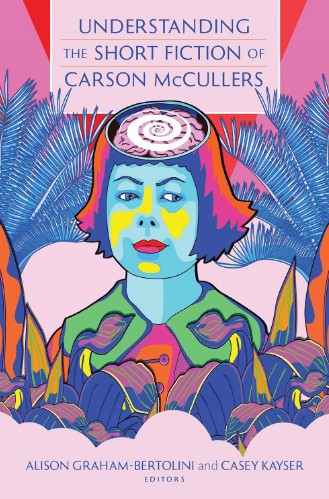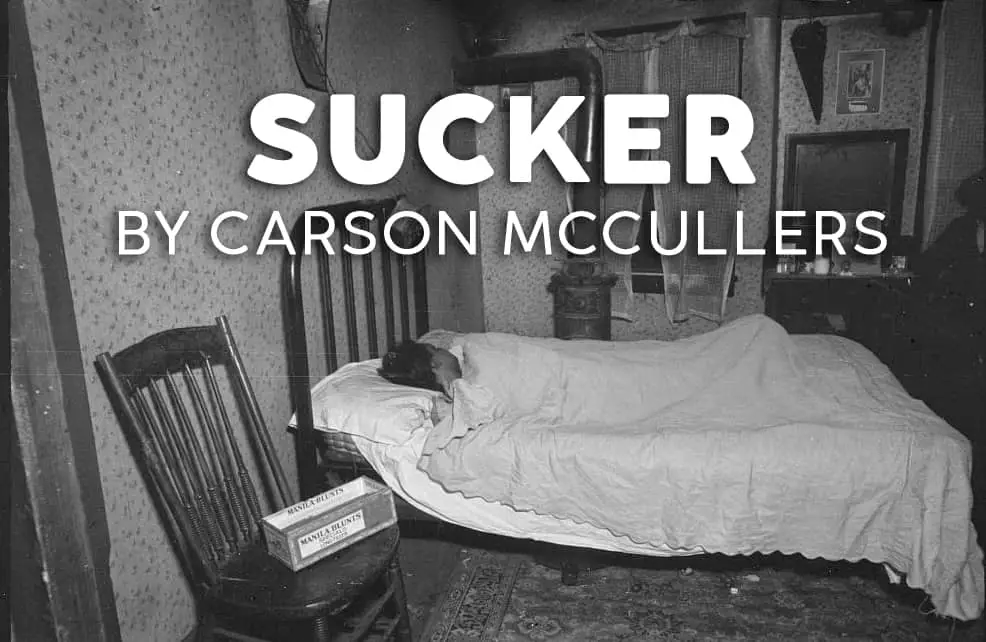“Sucker” has been called Carson McCullers’ ‘apprentice story’. It is thought that the young cousin in this short story is the precursor to Bubber Kelly in The Heart Is A Lonely Hunter. Written at the age of seventeen, McCullers naturally demonstrated more sophisticated writing later on, though I believe this is still a great story in its own right, and about the right level for the teenage, high school reader.
“Sucker” was written in the mid 1930s and published for the public in 1963.
For a while, McCullers forgot they ever wrote this story. “Sucker” was uncovered in her trunk of papers by someone studying her corpus for a thesis. By this time they were an established author. They never wrote “Sucker” thinking it would be published, but it was the first story they were happy to share with their family. They had written it by hand then typed it out on their first typewriter. Significantly, McCullers still liked this story after it was unearthed, and even though they had clearly grown more sophisticated as a writer. Many writers look back on their early work and cringe. Eleanor Catton can no longer enjoy The Rehearsal, for instance, saying she no longer writes in that style.
Note that I use they/them pronouns when talking about McCullers. We can’t know how they would have self-identified had they been born, say, 80 or 90 years later, and there’s ample evidence to support an argument of gender queerness in this 20th century author. ‘They’ is non-committal on my part.
WHAT HAPPENS IN “SUCKER”?
In “Sucker” two different stages of adolescent development collide. Pete and Sucker go through different psychological adjustments. The two boys discover the difficulties of adolescent romance, hero-worship, peer group formation and exclusion, and power reversal.
Ashley-Ann Woods, Adolescent Transformation in the Short Stories of Carson McCullers
Sucker is the nickname of a gullible 12-year-old boy — symbolically nicknamed, of course. Later in the story, Sucker will lose this insulting nickname, which will signal the shift in power dynamics. Sucker idolises his older cousin, Pete, who is not very nice in return. They have grown up in the same house, more like brothers than cousins. The age of twelve is pretty magical, in storytelling and in real life — people change a lot around this time. And so does Sucker in this story. He realises that his cousin Pete is not a good role model.
NARRATION OF “SUCKER”
You might expect such a plot to have been written from Sucker’s point of view, but no. This is all narrated by the sixteen-year-old cousin and reads like a catharsis in which Pete wrestles with his feelings of being adored while adoring someone who ignores him. Shit travels down, as they say.
Although Pete is sixteen at the time the story takes place, he must have had a little time to process all of this by the time he’s written it down. Storyteller narrators are like that — the reason for writing the story is to learn something. In the act of writing itself, they learn something. The Anagnorisis in such a story therefore occurs throughout the entire story, and you’ll typically find wise observations scattered throughout.
The arc of looking up to someone and then realising they’re not worth your effort is well explored in literature and film. Go back to Vladmir Propp, who listed the plot point in every single classic fairytale. (See step six, in which the main character is ‘tricked’ — often into trusting the untrustworthy Opponent.)
So McCullers made an excellent choice to examine this dynamic from the idol’s point of view. We hear less about the trials of being adored.
THE PSYCHOLOGY OF TRANSFERENCE
Shit travels down. That’s everyday speak for what psychologists call ‘transference‘. Freud came up with it. Transference describes a situation in which the feelings, desires, and expectations of one person are redirected and applied to another person.
In the case of “Sucker”, Pete is rejected by a girl he likes. So he deals with this highly uncomfortable feeling by rejecting his younger cousin in turn.
There are gender issues here, too. Boys, more than girls, are culturally conditioned to expect love and romance. Think of all those stories and computer games in which the ‘reward’ is a girl. Enter the teenage years. A few boys are so shocked to learn that a girl’s time and attention is not a god-given right that they feel a sense of injustice where they should simply feel sadness and disappointment.
Pete’s treatment of Sucker shows that he is trying to restore his own version of worldly justice by treating someone else as he has been treated.
Although Carson McCullers kept growing as an author, they demonstrated a preternaturally mature understanding of human psychology when they wrote “Sucker” at the age of seventeen. I can see why they always liked it.
SETTING OF “SUCKER”
Whereas all of McCullers’s novels are set in the South, only six of her short stories–“A Tree. A Rock. A Cloud,” “Art and Mr. Mahoney,” “The Haunted Boy,” “The March,” and two apprentice pieces, “Breath from the Sky” and “The Aliens”–make such a setting explicit. At least ten of her stories have obvious settings in the North, and three of her earliest stories (“Sucker,” “Like That,” and “The Orphanage”) have settings that could be anywhere (although the characters, dialogue, and events offer a kind of southern authenticity to the setting, which could well be McCullers’s hometown in Georgia or the fictional towns in which The Heart Is A Lonely Hunter and The Member of the Wedding are set).
Understanding Carson McCullers by Virginia Spencer Carr
STORY STRUCTURE OF “SUCKER”
SHORTCOMING
Robert Phillips (1978) said of Carson McCullers’ characters that they seem fine on the surface but suffer from an “inner freaking-out”. They are “spiritual isolates of circumstance”. Themes of rejection (and unrequited love) are seen over and over, in both her novels and in her short stories. (Worth pointing out because the short stories are qualitatively different from the novels.)
Pete is at the mercy of his own feelings of unrequited love toward a girl at school called Maybelle. Because of the environment in which he’s been brought up, these uncomfortable feelings are expressed as a silent, inward rage which must come out. Since he doesn’t have access to Maybelle, the target is Sucker. Sucker’s admiration for Pete only reminds Pete of his own admiration for Maybelle. Pete therefore has a strong Moral Shortcoming, treating his cousin very badly.
Pete is uncomfortable with being admired. This is probably because he doesn’t especially admire himself. He describes himself as a poor student. He feels Sucker is very stupid for admiring him. Stupid people are annoying.
DESIRE
Pete wants to go out with Maybelle. This is the outworking of a deeper Desire — to be loved for all the right reasons — for being himself.
OPPONENT
Maybelle is the romantic Opponent. Sucker is the proxy for the romantic opponent, since Maybelle is not there to heap shit on.
Proxy romantic partner is strongly suggested at various points — the boys share a bed; Sucker’s wrists look thin and white like girls’ wrists. Maybelle’s hands are similarly ‘little and white’. When Pete dreams of Maybelle, he hears Sucker’s voice — the characters become conflated. This is a kind of coitus uninterruptus trope.
PLAN
Pete’s focus is on getting Maybelle to like him in return, so he uses his own money to take her out to the movies, tries to impress her and so on.
BIG STRUGGLE
When Maybelle finally musters the courage to tell Pete she’s really not interested in him (I suspect she’s been trying to avoid hurting his feelings until now), Pete wakes up in the middle of the night squeezing Sucker’s arm really hard. Then he tells Sucker he’s never liked him, in a reenactment of what Maybelle has said to him.
ANAGNORISIS
By the time he narrates this tale, storyteller character Pete has already achieved the following wisdom: “If a person admires you a lot you despise him and don’t care… it is the person who doesn’t notice you that you are apt to admire”.
So how does the Anagnorisis phase work in a story like this, narrated by someone who has already had quite a few epiphanies, sprinkled like aphorisms throughout?
Basically, it comes much earlier. We are told of Pete’s Anagnorisis at the beginning, in fact.
But you could argue that Sucker is the main character of this story. For Sucker, the Anagnorisis comes in the expected place, right after the Battle. He realises Pete is not a worthy object of his affection and hardens up like the ‘man’ he is expected to be.
The reader can see that in the two or three months since this all happened, Pete has come to an understanding about how he treated Sucker badly. For him, the outcome isn’t bad. It’s doubtful he’ll do this exact thing to anyone else. He has started to call Sucker by his real name, Richard. This indicates a new respect. But the dynamics haven’t disappeared — they have been flipped. Now that Sucker doesn’t care about Pete, Pete suddenly cares quite a lot about Sucker.
It seems he hasn’t realised this yet, though the reader does. His Anagnorisis is only partial, as in all coming-of-age stories.
NEW SITUATION
Pete has wreaked much damage upon the character of Sucker, who has found another target of his admiration, this time it’s a bad lot of kids who may get him into irreversible trouble.
Sometimes, in service of us learning a valuable lesson, we damage someone else.

“Understanding the Short Fiction of Carson McCullers uses diverse critical techniques to identify how McCullers’s short fiction engages with the modern world and contemporary audiences. While McCullers’s longer work has received significant critical attention, her short fiction has not received the same treatment. This collection adds to analyses of McCullers’s better-known stories as well as considers those that have received little or no critical attention. McCullers’s writing maintains lasting appeal because it captures both the joy and sadness of humanity, especially the meaning we draw from connections with others and the pain of isolation when we find it difficult to cultivate these relationships in modern culture. While critical assessment of McCullers’s work has more often focused on her concern with loneliness and belonging, this collection depicts an author who was deeply invested in the social and political state of the world. Her short fiction includes interrogations of class-based, racial, and ableist prejudice, disconcerting portrayals of the social and political anxiety surrounding the Second World War, satirical eviscerations of some of the most oppressive social norms of the mid-twentieth century, and bold suggestions that lesbian desire, queer relationships, and female autonomy have a valid place in American culture. Through her depictions of differently-abled, sexually nonconforming characters, as well as characters of various races and classes, her short fiction redefines notions of belonging in the modern social context. The chapters within this collection provide new scholarly avenues to McCullers and will compel readers to rethink their own responses to McCullers’s shorter works”

